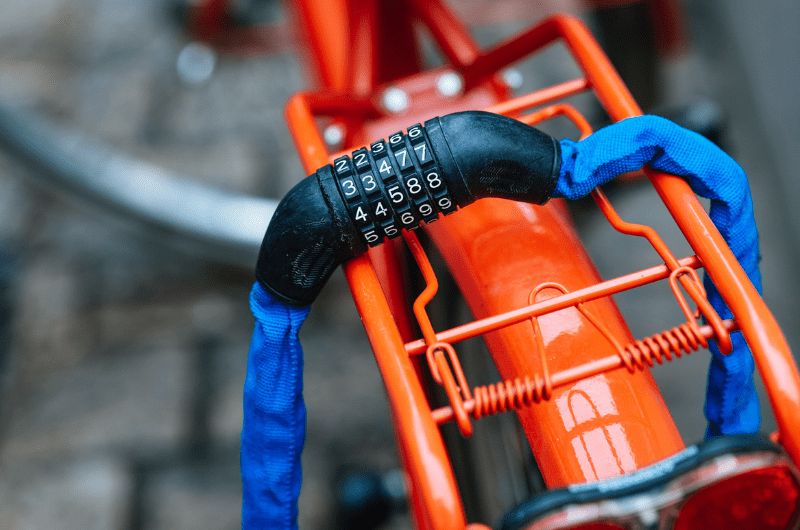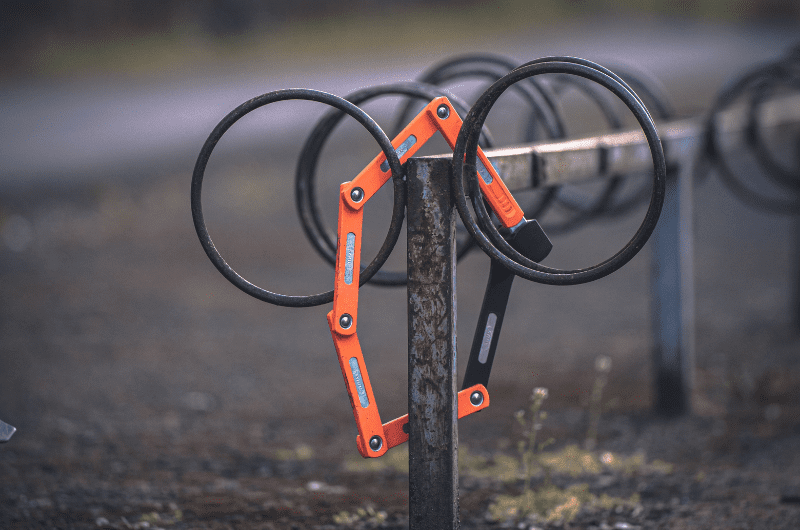Even the best bike lock cannot guarantee your bicycle will be waiting when you return to it. Over 100,000 were stolen per year in England and Wales from 2002 to 2021. As cycling becomes more popular as a commuting alternative, a marketplace for stolen models is created.
Thieves will look for the quickest and quietest way to take a bicycle. Find areas with CCTV, or near areas with security patrols. Check the area around you – abandoned single wheels are evidence of a popular area for bike thieves.
Build in some time to your commute to find the safest spot. Find something immovable that you can legally attach it to. Attach the frame and wheels where possible. Avoid placing the lock where it can easily be levered or smashed. Higher up is better. If you ride with someone else, combine your locks for more protection.
Types of Bike Lock
| Type | Main Feature |
| D-lock | Toughened shackle |
| Chain lock | Adaptable |
| Cable lock | Lightweight |
| Foldable lock | Convenient |
D-Lock (AKA U-lock)
What is a D-Lock?
D-locks are the most common type of bicycle lock. They are often referred to as U-locks because of the distinctive shape of one part when unlocked. They’re like a big padlock, and are considered particularly strong and reliable. These are great for day-to-day use.
D-locks are made up of two parts. There’s a U-shaped steel shackle, and the barrel-shaped locking device. As you join them together, a D-shape is formed. They’re considered a highly acceptable form of discouragement for thieves.
D-locks are presented in a wide range of sizes and materials, and also an array of prices. They’re capable of working in the majority of locations, and suit any bicycle. Obviously there are fixed boundaries of use for such a solid mechanism, but they can be used to secure wheels, any quick release components, or even parts you carry with you to the frame.
The more removable parts you have, the more chances are that you should consider adding a cable to the D-lock set up.
D-Lock [PROS + CONS]
| Pros | Cons |
| Strong and reliable | Heavy |
| Great in tandem with a cable | May not be wide enough for all immovable objects |
| Wide range of sizes | Might not fit through all types of frame |
Are D-Locks Secure?
The feedback is generally positive about D-Locks, providing that they are correctly and sensibly used. Testers and certification companies tend to be aligned in testing the parameters of locks. Manual and power tools are used, along with force and delicate skill.
The best D-locks have the highest torsional resistance. This is when the lock defies the act of being twisted. Likewise, the best D-locks perform well under tensile strength resistance – defined as the ability to pull apart. As the prices increase, the tensile strength difference between models is the same as two vans pulling at either end of the lock.
D-locks perform well in bolt cropping tests and sawing. Overall, they are considered to be a great deterrent. This is evident in the amount that are seen used in bicycle sheds and bicycle parking areas the world over.

Chain Lock
What is a Chain Lock?
Chain locks are widespread amongst motorbike users, and are perfectly acceptable for the same purpose of locking bicycles. At the higher end of the price range, a toughened metal chain link is bound in kevlar (used for flak-jackets) which will try to stand up to cutting tools.
The loop of a chain lock is connected by a padlock, and you should ensure that the quality and strength of the chain is not compromised by it. The best ones will have a sturdy padlock, made to be hostile to damage caused by impact or lock-pickers.
Chain locks offer a little more flexibility than D-Locks or cable locks and so tend to be more expensive, pound for pound. They do tend to be heavy, but come with the adaptability of being able to be strapped around your waist or chest.
Please pay particular attention and care if you plan to do this as your injuries may be considerably worse in the event of an accident if you have such dense, immovable objects close to your body and suffer a fall. Some weigh over 4kg, so may also damage a frame if dropped from height.
Chain Locks [PROS + CONS]
| Pros | Cons |
| Can be looped around any bicycle | Can be hard to carry |
| Great visual deterrent | Heavy |
| Fantastic in tandem with a ground anchor | Careful locking required to avoid gaps between bicycle and immovable object meaning leverage for tools increases |
Are Chain Locks Secure?
Chain locks fare well against the hammer test. They don’t all perform as well as D-locks against bolt-cropping, although they do well against the lock shackle. Portable chain locks are usually 12mm in width at most. You’ll be giving up more in security but they are a fantastic visual deterrent.
A link that is 16mm thick is considered enough to deter the most commonly used bolt-cutters, and there are plenty of chain locks at this level. However, you’ll be carrying over 4kg in extra weight. We have a look at chain locks versus D-locks here.

Cable Lock
What is a Cable Lock?
The pliable, adaptable characteristics of cable locks are for many cyclists a great option. They extend and secure themselves around a range of immovable items so are very practical. Being the lightest weight, they support commuting to and from the safest areas.
Easily the best suited to a budget, and with a wide range in the market, they offer plenty of deterrents at the higher end of the price spectrum. Some are suited to being a visual deterrent only.
Cable Lock [PROS + CONS]
| Pros | Cons |
| Flexible | Most ‘at-risk’ from the most types of attack |
| Lightweight | Can be quickly cut by bolt-cutters |
| Very portable | Not the best visual deterrent |
Are Cable Locks Secure?
Cable locks tend to feature low down on the comparison charts of the different types of lock in the marketplace. What they offer in terms of practicality and weight, they lose in terms of deterrent and time to break.
Even if you think your bicycle is not desirable or expensive, remember that a thief doesn’t see it as anything more than an asset they can sell or move on. Bolt-cutters cut each of the individual cables within the unit one-by-one. Cables may be better as a secondary lock to a cable lock or D-lock.
Folding Lock
What is a Folding Lock?
A folding lock is constructed of metal plates which are connected by rivets. The plates are able to rotate, which gives a folding lock the ability to bind around all manner of objects and in lots of scenarios. Folding locks are many-sided and can be compacted down to a very manageable size.
Folding Lock [PROS + CONS]
| Pros | Cons |
| Take up very little space | Perceived weakness of multiple joints |
| Most likely to support your bicycle’s aesthetics | Patience and care needed when using |
| Adaptable to more immovable objects | Might not work after a partial attack |
Are Folding Locks Secure?
Folding locks might not be as secure as D-locks but they appear to be a more suitable deterrent than cable locks. You will be offered a wider range of possible immovable objects to lock your bicycle and lokcing two bicycles is not impossible. They tend to be at the lower end of recognised security ratings and might not be suited to occasions where your bicycle is not in your eyeline 100% of the time.

How Are Bike Locks Rated?
Bicycle locks are rated on different categories, as users need them for different purposes. The accepted industry standard is Sold Secure. They offer four recognisable ratings from bronze up to diamond. This gives information to help with choice. Their services are recognised in the UK and the USA.
Stichting ART is a Dutch company and offers an alternative five star rating. It’s more of a co-operative agreement between insurers, cycle touring clubs aiming to promote certain products. Discerning cyclists will know our love for all things about Dutch cycling, but the fact that this company has no areas of The Netherlands that are classed as low risk for theft is startling.
Consumer groups and even manufacturers will provide rating and insurance companies will give advice and guidance (and may have minimum requirements). It’s worth a quick look at your insurance documents to determine how they will pay your claim. Some now insist on being your bike being locked to an immovable object, and using a certain rated lock.
Sold Secure, who we look at here, has at least ten pages of locks on their site. A quick look at one review shows essential detail on the company, and has the Grading prominently displayed. It’s a no-nonsense approach. The ratings increase as more, or more enhanced tools, are used by opportunist thieves.
Tests will examine resistance to drilling, cutting, levering and lock picking, with a stopwatch on hand to time how long an attack takes. It can’t fully recreate real world scenarios of town centres, or darkened train station bike racks. A quick look on YouTube or police force websites will provide you with ‘real world’ reviews.
Which Type of Bike Lock is Best?
The arguments for a D-Lock with a cable are hard to beat. Their strength and compatibility with urban street furniture and locking areas more than make up for their weight and supposed lack of portability. They fit on the bike easily and securely when not in use.
Taking a cable along is really useful for any accessories or quick release wheels that might need to be secured next to the frame. Pay attention to the things at your locking location that you can control, like light, visibility, evidence of other stolen bikes, and also how you lock your machine. This way, you’ll only add to the benefit of choosing a good Sold Secure rating.
The post Types of Bike Locks (and Which is Best?) appeared first on Discerning Cyclist.
